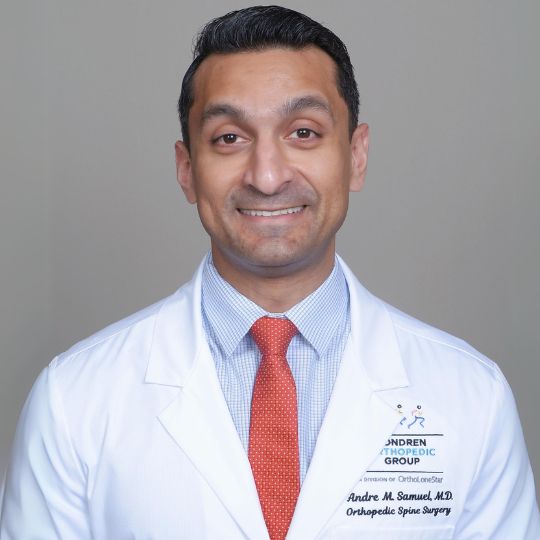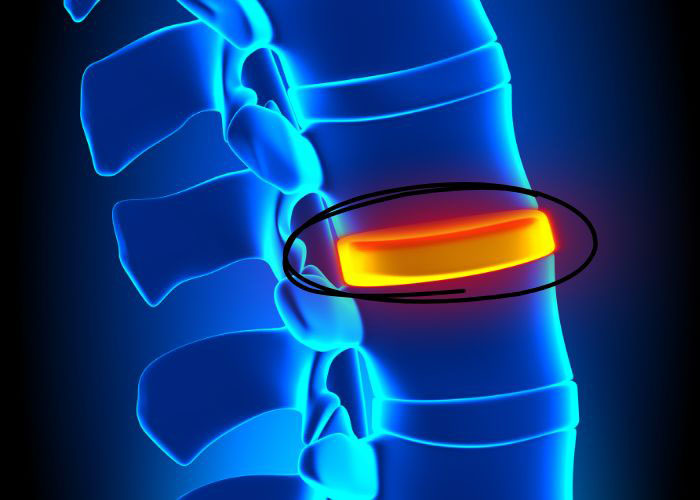Disc Replacement Surgeon
Cervical disc replacement is a surgical treatment for patients with continued nerve pain after a trial of conservative therapies. An artificial disc is implemented and secured in place with metal brackets or plates attached to the surrounding vertebral surfaces. Doctor Andre M. Samuel, orthopedic spine specialist offers both surgical and non-surgical treatment options for patients in Clear Lake, Houston, and Sugar Land, Texas area, who are experiencing continued nerve pain after conservative neck and spine therapy. Contact Dr. Samuel’s team today!

What is cervical disc disease?
Cervical disc disease encompasses a variety of cervical spine conditions that can lead to long-term nerve damage. Over time, the cervical spine can deteriorate causing a loss of space between the vertebrae and decreasing overall range of motion. Some individuals may experience a bulging disc that puts pressure on the nerves causing numbness, tingling, and sharp, shooting pains. A traumatic event, such as a motor vehicle collision, can also damage the cervical spine leading to early onset degenerative disc disease.
What is the treatment for cervical disc disease?
Individuals who experience nerve pain from the cervical spine often benefit from conservative therapy options. These include physical therapy, short-term immobilization with a cervical collar, and non-steroidal anti-inflammatory medications.
However, if conservative therapies prove unsuccessful, or the nerve symptoms continually impact an individual’s activities of daily living, a cervical disc replacement may be necessary. Cervical disc replacement, also known as an arthroplasty, is a surgical treatment option for individuals who have exhausted all other treatment avenues. The diseased disc is replaced with an artificial disc that preserves motion within the neck, different from a cervical fusion surgery (or ACDF) which limits motion after surgery. Dr. Andre M. Samuel, orthopedic spinal doctor, treats patients in Sugar Land, Pearland, and the Houston, Texas area, who have cervical spine nerve damage and are in need of a cervical disc replacement.

How is a cervical disc replacement performed?
Cervical disc arthroplasty is performed under general anesthesia and may take anywhere from 1 to 3 hours to complete, depending on a number of patient factors. While there are different methods of securing the artificial disc implant, the overall procedure remains the same. To begin, a small incision is created along the side of the neck. Dr. Samuel carefully moves the interfering soft tissues and protects them away from the surgical site. The damaged cervical disc is confirmed using x-ray fluoroscopy. The vertebrae surrounding the damaged cervical disc are separated and the disc with its contents are extracted. Dr. Samuel will inspect the empty intervertebral space and remove any protruding bony formations such as osteophytes. The artificial disc implant is then inserted into the intervertebral space. Dr. Samuel may trial different-sized implants to best serve the patient’s needs. X-ray imaging is used to ensure proper fit and alignment of the new implant. Once the new implant is secured, the surgical instruments are removed and the incision is closed with sutures. Dr. Samuel will determine the best method for securing the artificial disc implant after reviewing a number of patient factors such as age, activity level, and medical history.
What is the recovery period like after a cervical disc replacement?
Cervical disc arthroplasty is typically performed as an inpatient procedure, so most patients can expect to spend 1 to 2 days in the hospital for close monitoring. However, based on a number of factors, certain individuals may be able to go home the same day. Patients in the Houston, Texas area can expect a return to normal daily activities approximately 4 to 6 weeks after cervical disc replacement. The following can be anticipated during the recovery process:
- Application of a cervical collar to limit neck motion during the first 2 weeks after surgery. Movement of the neck is encouraged as soon after surgery as possible.
- Due to general anesthesia and the retraction of important neck structures, patients may experience a sore throat, hoarse voice, or difficulty swallowing that can last anywhere from 1 to 4 weeks.
- Over-the-counter non-steroidal anti-inflammatory medications can be used to alleviate any post-operative pain. Dr. Samuel may prescribe a short course of stronger pain medication to be taken as directed.
- Once the incision is healed, Dr. Samuel may recommend at-home physician-directed neck stretches in addition to a physical therapy program tailored to improve cervical spine range of motion, muscle strength, and overall mobility.



